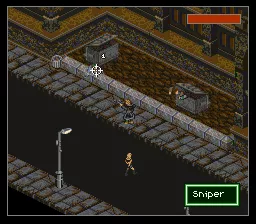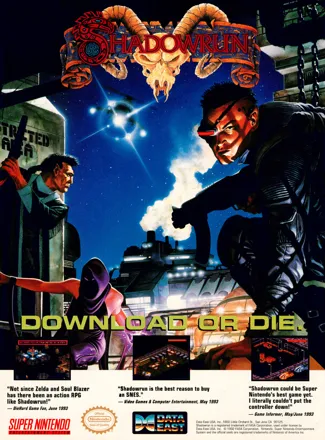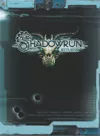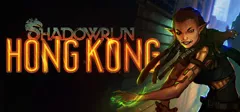Shadowrun
Description official description
After the Awakening, magic has been re-discovered, and human beings have accepted the existence of those they thought to be fantasy creatures. Mega-corporations and cyberworlds had to give space to elves and Native American shamans. Jake Armitage was a seemingly ordinary data courier, assassinated by a hit squad in the year 2050 in Seattle, Washington. Miraculously, his true story began after his death. A mysterious figure approached Jake and cast a spell on him; after that, he woke up in the morgue.
Jake doesn't know what happened to him, he doesn't even remember his own name. He is contacted by a shamanistic Dog totem with a cryptic message about his mission. Wandering through the large city where monorails, computers, and street gangs armed with automatic weapons co-exist with orcs, dwarves, and vampires, he begins to unravel the mystery, gradually learning about dangers awaiting him around every corner, and his own past.
Shadowrun is based on the pen-and-paper role-playing game of the same name, more specifically on the novel Never Deal with a Dragon by Robert Charrette. It is entirely different from the Genesis adaptation of the same license. The game is a skill-based RPG with action-oriented combat. Most of the time Jake uses firearms; he can also learn magic spells, primarily with defensive and support capabilities. The player can hire "deckers", temporary party members who can aid Jake in battles, and to whom the player can assign basic commands or let them be controlled by the AI.
Karma points are awarded to the player for successfully eliminating enemies. These act like experience points in other RPGs and can be manually distributed by the player. The player can increase the character's basic parameters (such as hit points or charisma), as well as have him master various skills. These include firearms, computers, negotiation, leadership, and others.
Jake can also use his cyberdeck to access cyberspace known as the Matrix, for plot-related purposes or in order to obtain money. Represented by an icon, Jake moves through the cyberspace, fighting programs that protect data from intruders. Jake's success in these endeavours largely depends on his computer skill.
Dialogue with non-playable characters plays an important role. Most quests involve Jake exploring various locations in Seattle and gathering information from people. Conversations are topic-based; often it is necessary to learn about a particular topic from a specific character and then choose it in a conversation with another one to obtain the necessary information.
Spellings
- シャドウラン - Japanese spelling
Groups +
Screenshots
Promos
Credits (SNES version)
31 People · View all
| System Programming | |
| Game Programming | |
| Artwork | |
| Additional Artwork | |
| Game Design | |
| Map Construction | |
| Music | |
| Game Testing | |
| [ full credits ] | |
Reviews
Critics
Average score: 81% (based on 22 ratings)
Players
Average score: 3.8 out of 5 (based on 59 ratings with 4 reviews)
In my opinion, one of the all time greats!!!
The Good
The play control was quick and responsive, the story was engaging, and the graphics were well suited to the entire mood of the game.
The Bad
Although the graphics were well suited I would have liked for the character size to be a bit larger and the onscreen detail a little more in depth.
The Bottom Line
An awesome RPG experience, that i have and will continue to play over and over.
SNES · by Tarzan Dan (25) · 2004
The Good
This ambitious game looked to push the limit of what you could do on the SNES. Half RPG and half shooter the creators tried exceptionally hard to recreate the experience of a tabletop Shadowrun on your SNES, and succeeded in many elements.
The Cyberpunk noir detective story of your own past wasn't the height of gaming story lines, but it was straight forward and fun. There was plenty of opportunity to talk to residents, shady bartenders, and lewd strippers. If that isn't enough, you can also surf Web 3.0 as envisioned by William Gibson as a digital avatar shooting lightning. Hacking isn't guessing passwords or uploading a subroutine, instead you fight computer defenses in a cyberworld dungeon. And yes, it was done much better than "Johnny Mnemonic".
And the developers don't hold out on you with the goodie bag either. Not only do you begin the game as an elite "Decker" who hacks into computers for wealth and clues, but you progress onwards to also become a street Shaman with your own Totem. Fighting off zombie gangers with magic, machine guns, and hacking? In the Shadowrun world this is equivalent to letting you ride a unicorn wielding a burning flail that pulverizes your antagonists.
The Bad
There just wasn't enough buttons on the controller to fit in all the features Shadowrun. Combat requires sitting still and moving your targeting reticule over targets while they can both charge and attack you simultaneously.
The graphical limitations of the SNES aren't what holds the game back either, simply it is the lack of having 2 8-direction D-Pads. A potentially better combat system would involve an auto-target and target-cycling while allowing the freedom of movement on the D-pad.
Also there is a brief period where you have tag-along buddies, whom solely for personal reasons you don't want to die. Unfortunately they will die, and it will be a chore to keep them alive. While it amounts to only a minor story detail it is a failing that you are unable to control the AI tactics of your comrades.
And the music is completely unmemorable, meaning it must have been so bad I played the entire game muted or listening to the theme music to "Johnny Mnemonic".
The Bottom Line
Cyberpunk doesn't get much better than this. Shadwrun comes complete with stats, level building, the DayGlo world of the matrix, and the much loved Blade Runner ambiance.
There are hours of gameplay to enjoy after getting over/use to the combat system oddities, and even being a part of it's graphically appealing world is fun in of itself.
And it even tries to be an existentialist review of technology and humanity, even if it's a bit short on story. If there's a Sci-Fi element it's missing, it's an extra hand to use munching on popcorn. Because you will have to use a lot of thumb maneuvering to kill that ganger in the dumpster, let alone the charging street Samurai.
SNES · by patrick quinn (6) · 2010
The Good
Shadowrun was actually the first console game I seriously sat down and played
- And this was only two weeks ago!
Yep, I decided to check out the past I never had and explore the delights of classic console gaming. How appropriate then, that I picked an absolute masterpiece to start off with.
From the moment I started playing Shadowrun, I was hooked. The moody isometric graphics, compelling soundtrack and instantly engaging gameplay all combined to make this an addictive experience. This is an extremely atmospheric game. I've played a lot of games set in bleak, obviously Blade Runner-inspired futures, with hacking, cybernetic implants, guns, smoke and guys in dark trenchcoats, but this is definitely one of the best.
The gameplay is surprisingly deep, with a lot of things to do, and a lot of flexibility about the way you go about things. Conversations with other characters are generally brief, but nearly every line carries you on, and seems to add to the richness of the gameworld. Similarily, clues scribbled on scraps of paper or found lurking in cyberspace reveal more of the plot in ways which, through their very sparseness, make it all the more involving. New technology and skills are drip-fed to you in the best possible way, but as you need the money to buy things and the 'karma' (experience) points to upgrade your skills, you are always striving to reach the next level. Usually, in RPGs, the levelling system is quite uninvolving; You just fight a lot of battles and are occasionally pleasantly surprised when you get a 'level up' message. In Shadowrun, though, you have to collect points and then you decide when you're going to use those points and how you're going to spend them. This may seem like a small distinction, but it really works to maintain your addiction and keep the game rattling along.
A lot of the gameplay is satisfyingly adventure-based. There are traditional inventory-item puzzles, but they generally tend to be logical, obvious in their use in furthering the story and they nearly always open new areas or allow you to do exciting new things.
I keep coming back to this, but one of Shadowrun's greatest strengths is in the way that it constantly presents players with things they want, but which they can't quite get - yet. This is the hook, and is one of the key components of great game design. Whether it's a gun you want but can't quite afford, a locked gate that you need to find a key for, or a spell that you need to find another component for, Shadowrun excels in keeping you hungry. And that makes it all the better when you get what you want. And then there's something else you want, after that! It's very cool.
Fighting is extremely simple, but generally fun. Hacking is an interesting subgame that, while not great (Hacking in games is rarely great), certainly offers a refreshing change of pace. Adventuring, exploring, and RPG levelling are where the game really scores, and where you get to soak in that thick, thick atmosphere and tingly addictive gameplay. Oh yeah, and the attention to detail is awesome too - There are optional subquests, different ways of solving some puzzles, intricately detailed graphics, all kinds of fun stuff and all kinds of things that the designers didn't need to throw in, but did because they obviously enjoyed creating this game. Excellent example: Late in the game, you kill a huge serpent beast. When it dies, it leaves some scales on the floor. If you examine them, the description is something like 'Slimy scales from the dead serpent.' Try to pick them, and you can't. Try again, and they scoot across the floor. Finally, on the third or fourth attempt, you manage to get them. The scales were slimy and they slipped from your hand! Totally pointless, but very cute.
Have I made it clear yet? This is one compelling, fun-packed, involving, deep
cyberpunk-y RPG. It reminded me of System Shock and anyone who knows me can
tell you how much I worship that game.
The Bad
The game falls down in two areas: Its combat and its party recruiting.
The combat is very basic. When you're not just running around, you change between different cursor modes. You either use the hand cursor to manipulate the environment, the spell cursor to cast spells or the crosshairs cursor to fire. Because you're switching from movement to cursor mode, you can't move when doing any of these things. In combat this means that you change to the crosshairs, move them over your enemy and blast away. You can't move. Well, you could, but you'd have to temporarily lose the crosshairs as you switched back to movement mode, then switch back to firing mode...You see what I mean. It's just not worth it, because you'd lose too much time even trying to move. So every battle basically consists of you standing still and hammering the fire button while the cursor is over the top of your enemy. Meanwhile, they do the same to you. And the AI is very basic, too. For normal enemies, it's pretty much nonexistant. Most of the time, they will stand completely still and fire back at you. When you get some spells, combat does improve, and become a little more tactical, but it's still rather too basic. I actually bought my first control pad after playing this game for a while. That is definitely a good thing, but the reason for it isn't - I seriously could feel the beginnings of RSI in my wrists from pummelling the same key over and over again. Anyway, despite it being so basic (and despite the possiblity of wrist hurt disease), combat is actually pretty good fun. It's satisfying to watch enemies flash and die (Hmm!) and you always want to get a bigger gun so you can deal more damage. I just think they could have rethought the system a wee bit and allowed you to move and fire at the same time. Some enemy AI wouldn't have hurt, either.
The second point where Shadowrun falls down is party recruiting, which is
almost entirely pointless, and again, the fault must lie at the feet of the AI
routines (or rather, the lack of them). I don't know much about the Shadowrun
universe beyond this game, but it seems pretty clear that a big part of it is
the idea of gangs of Shadowrunners running around together. Here, it's really
not worth it. You can hire whoever you want from the motley bunch hanging out
at various bars and clubs across the city. They all have different strengths
and weapons and you can hire fighters, mages or deckers (If your cyber skill
is not high enough, you can get them to plug into the net instead of you).
Party members follow you around blindly and will start shooting when you run
into some enemies. This can be useful to add extra guns to a hot situation,
but the problem is that your party members have no intelligence whatsoever.
They won't move (except to follow you), they won't run away if they're about
to die and they won't ever try to heal themselves. Even mages, who are loaded
up with heal spells, will never use them, unless you explicitly tell them to.
Yes, you can tell people to move, or to use different spells, but to do this,
you have to change from fire mode to the 'hand' mode, move your cursor over to
the party member, and then select what you want them to do. In the middle of a
exchange of hot lead with a seriously hard orc ganger, this takes way too
long. In fact, when you have a party with you, you'll spend most of your time
checking on their health, and desperately trying to medikit them before they
die. I hired a mad uzi-toting dwarf, called Norbert, near the start of the
game, and together we took out the leaders of the Rust Stilettos gang. That
was fun, but back then, my own firepower and health were too limited. I soon
realised it was a lot better to save money and get myself a better gun that to
waste it hiring idiots who were just going to stand there and get shot. From
then on, I went solo. I had no complaints about this, as the gloomy
Bladerunner-ish future is usually a lonely place, with one desperate person
fighting against whole evil MegaCorps, but I'm sure fans of the original RPG
would be rather upset about the near-uselessness of hiring in this game.
The Bottom Line
Whoah! Well, my 'complaints' section was quite long, but it was only two
points and one of them (the combat) managed to be fun despite it being so
basic and the other (recruiting) was disappointing, but it was fine being on
your own, anyway.
So know this: Shadowrun for the SNES is a truly excellent game. It's rich in atmosphere, gameplay and fun, and it kept me playing solidly into the small hours for a week or so. It's actually one of the best games I've ever played, comparing favourably with the likes of more recent mega-smashes such as Deus Ex. Even more than that, it's now got me hopelessly addicted to console gaming. I'm playing Chrono Trigger, loving every minute of it, and I now walk boldly forward into a console-loving future, wearing my smoky grey trenchcoat, SNES in one hand and AS-7 assault cannon in the other.
SNES · by xroox (3895) · 2003
Trivia
1001 Video Games
Shadowrun appears in the book 1001 Video Games You Must Play Before You Die by General Editor Tony Mott.
Genesis version
Sega sub-licenced the Shadowrun IP from Data East. Due to a number of factors, the Genesis version was completely different from Data East's SNES version.
Inspiration
Be aware that this trivia section contains spoilers!
The plot of the game is heavily based on the first Shadowrun novel by Robert N. Charrette, Never Deal with a Dragon, first published in 1990. The similarities include: * a protagonist who starts as a decker but discovers he has shaman powers and is attuned to the totem Dog. * Aneki's corporation trying to launch an AI to take over the Matrix (in the pen-and-paper Shadowrun RPG, Aneki is the CEO of a megacorporation named Renraku with similar goals.) * A dragon villain called Drake ("Mr." Drake in the novel)
It's also interesting to notice that the plot about the AI was only resolved in the third edition of the pen-and-paper game (published in 1998, several years after the SNES game).
Kitsune
One of the game's characters (in the SNES version), a charming human/fox shapeshifter girl, is called Kitsune. "Kitsune" is Japanese for "fox".
Information also contributed by Pirou Julien
Analytics
Upgrade to MobyPro to view research rankings and price history! (when applicable)
Identifiers +
Contribute
Are you familiar with this game? Help document and preserve this entry in video game history! If your contribution is approved, you will earn points and be credited as a contributor.
Contributors to this Entry
Game added by Trixter.
Additional contributors: Alaka, FatherJack, Rounin.
Game added March 17, 2003. Last modified February 13, 2025.






















